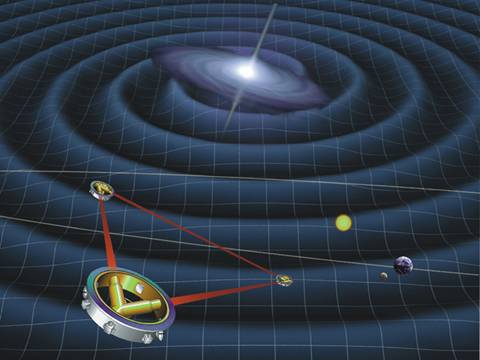A Wrinkle in Space-Time
When a massive star reaches the end of its life, it can explode into a supernova rivaling the brilliance of an entire galaxy. What's left of the star fades in weeks, but its outer layers expand through space as a turbulent cloud of gases. Astronomers see beautiful remnants from past supernovas all around the sky, one of the most famous being the Crab Nebula in Taurus.
When a star throws off nine-tenths of its mass in a supernova, however, it also throws off nine-tenths of its gravitational field.

LISA's three spacecraft will be positioned at the corners of a triangle 5 million kilometers
on a side and will be able to detect gravitational wave induced changes in their separation
distance of as little as one billionth of a centimeter.
Astronomers see the light from supernovas. Can they also somehow sense the sudden and dramatic change in the exploding star's gravitational field?
Yes, they believe they can. According to Einstein's general theory of relativity, changes in the star's gravitational field should propagate outward, just like light'indeed, at the speed of light.
Those propagating changes would be a gravitational wave.
Einstein said what we feel as a gravitational field arises from the fact that huge masses curve space and time. The more massive an object, the more it bends the three dimensions of space and the fourth dimension of time. And if a massive object's gravitational field changes suddenly'say, when a star explodes'it should kink or wrinkle the very geometry of space-time. Moreover, that wrinkle should propagate outward like ripples radiating outward in a pond from a thrown stone.
The frequency and timing of gravitational waves should reveal what's happening deep inside a supernova, in contrast to light, which is radiated from the surface. Thus, gravitational waves allow astronomers to peer inside the universe's most violent events'like doctors peer at patients' internal organs using CAT scans. The technique is not limited to supernovas: colliding neutron stars, black holes and other exotic objects may be revealed, too.
NASA and the European Space Agency are now building prototype equipment for the first space experiment to measure gravitational waves: the Laser Interferometer Space Antenna, or LISA.
LISA will look for patterns of compression and stretching in space-time that signal the passage of a gravitational wave. Three small spacecraft will fly in a triangular formation behind the Earth, each beaming a laser at the other two, continuously measuring their mutual separation. Although the three 'craft will be 5 million kilometers apart, they will monitor their separation to one billionth of a centimeter, smaller than an atom's diameter, which is the kind of precision needed to sense these elusive waves.
LISA is slated for launch around 2015.
To learn more about LISA, go to http://lisa.jpl.nasa.gov. Kids can learn about LISA and do a gravitational wave interactive crossword at http://spaceplace.nasa.gov/en/kids/lisaxword/lisaxword.shtml.